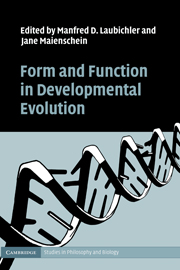Book contents
- Frontmatter
- Contents
- List of figures
- List of tables
- List of contributors
- List of journal abbreviations
- 1 Introduction
- 2 Form and function in Evo Devo: historical and conceptual reflections
- 3 Deducing plant function from organic form: challenges and pitfalls
- 4 Evolution in the light of embryos: seeking the origins of novelties in ontogeny
- 5 A focus on both form and function in examining selection versus constraint
- 6 Innovation and diversity in functional morphology
- 7 The developmental evolution of avian digit homology: an update
- 8 Functional analysis and character transformation
- 9 The nature of constraints
- 10 Toward a mechanistic Evo Devo
- Index
- References
5 - A focus on both form and function in examining selection versus constraint
Published online by Cambridge University Press: 28 June 2009
- Frontmatter
- Contents
- List of figures
- List of tables
- List of contributors
- List of journal abbreviations
- 1 Introduction
- 2 Form and function in Evo Devo: historical and conceptual reflections
- 3 Deducing plant function from organic form: challenges and pitfalls
- 4 Evolution in the light of embryos: seeking the origins of novelties in ontogeny
- 5 A focus on both form and function in examining selection versus constraint
- 6 Innovation and diversity in functional morphology
- 7 The developmental evolution of avian digit homology: an update
- 8 Functional analysis and character transformation
- 9 The nature of constraints
- 10 Toward a mechanistic Evo Devo
- Index
- References
Summary
One of the challenges for a modern integrative biology is to more fully understand why assemblages of related species occupy morphospace in the way they do. An integration of analyses of both form and function is required to achieve this goal. The burgeoning understanding of development in emerging model species is providing evolutionary biologists with the potential to explore contributions to the evolution of patterns in morphospace by the processes involved in making variation in forms as well as those resulting from their performance in natural environments. Such an approach is illustrated here by drawing on work on butterfly eyespot patterns and scaling relationships. Relevant studies are being performed in some other groups of animals (see Brakefield 2006), and progress is also being made in plants (see Langlade et al. 2005; Niklas, ch. 3 in this volume).
Patterns in morphospace have always fascinated biologists, especially when they are known to reflect adaptive radiation among new ecological niches. In such examples, while there can be no doubt that natural selection plays a major role in shaping the evolution of morphological diversity and disparity, it is by no means clear how much the processes involved in generating variation in the phenotype to be screened by the natural selection also contribute. Thus, the extent to which evolution by natural selection of adaptations to local environments is compromised or biased by the genetical and developmental origins of phenotypic variation remains an open issue.
- Type
- Chapter
- Information
- Form and Function in Developmental Evolution , pp. 112 - 131Publisher: Cambridge University PressPrint publication year: 2009
References
- 1
- Cited by



